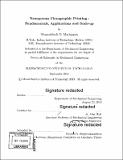| dc.contributor.advisor | A. John Hart. | en_US |
| dc.contributor.author | Mariappan, Dhanushkodi D.,1979- | en_US |
| dc.contributor.other | Massachusetts Institute of Technology. Department of Mechanical Engineering. | en_US |
| dc.date.accessioned | 2020-02-10T21:43:57Z | |
| dc.date.available | 2020-02-10T21:43:57Z | |
| dc.date.copyright | 2019 | en_US |
| dc.date.issued | 2019 | en_US |
| dc.identifier.uri | https://hdl.handle.net/1721.1/123773 | |
| dc.description | Thesis: Ph. D., Massachusetts Institute of Technology, Department of Mechanical Engineering, 2019 | en_US |
| dc.description | Cataloged from PDF version of thesis. | en_US |
| dc.description | Includes bibliographical references (pages 127-134). | en_US |
| dc.description.abstract | Printing of ultrathin layers of polymeric and colloidal inks is critical for the manufacturing of electronics on non-conventional substrates such as paper and polymer films, for applications such as smart packaging, asset tracking, and photovoltaics. Among conventional printing processes, flexography is a scalable, high-speed direct printing method, yet its resolution is limited by squeeze-out of ink between the non-porous stamp and substrate and by dewetting of the deposited ink film. Broadly, there remains an important need for improved printing technologies for ultrathin (~0.1 [mu[m or smaller) and fine features (~ [mu]m resolution) to advance printed electronics technology. In flexographic printing, it was recently demonstrated that significantly finer printed feature dimensions can be achieved when nanoporous stamps are used instead of traditional non-porous polymer stamps. | en_US |
| dc.description.abstract | This thesis studies the fundamentals, applications and scalability of flexography using nanoporous stamps. - First, the dynamics of liquid transfer between nanoporous stamps and solid substrates are studied. The stamps comprise forests of polymer-coated carbon nanotubes (CNTs), and the surface mechanics and wettability of the stamp are engineered to imbibe colloidal inks and transfer patterns by conformal contact with the substrates. By high-speed imaging during printing we observe the dynamics of liquid spreading, which is mediated by progressing contact between the nanostructure stamp surface and the substrate, and by imbibition within the stamp-substrate gap. Via modeling of the liquid dynamics, and comparison with data, we elucidate the scale- and rate-limiting aspects of the process. Specifically, we find that the printed ink volume and resulting layer thickness are independent of contact pressure, and thickness decreases with retraction speed. | en_US |
| dc.description.abstract | - Second, the design and evaluation of a benchtop plate-to-roll (P2R) machine for rapid prototyping of printed patterns is presented. The machine accommodates CNT stamps up to 20 x 20 mm size, and controls the contact force, contact speed, and the alignment between the stamp and the substrate. Using the P2R machine, we show printing of honeycomb patterns with 3 [mu]m linewidth at >0.1 m/s demonstrating the scalability of the process for high-throughput manufacturing. - Third, simple devices are prototyped to leverage the capabilities of nanoporous flexography. Ultra-thin (<500nm), short channel (~10 [mu]m) transistors are fabricated using flexoprinted silver electrodes (followed by sintering), with a uniform thin film of single walled carbon nanotubes (SWCNTs) as the active layer. The measured on-off ratios (~ 10³ - 10⁵) and mobilities (25-95 cm² /Vs) are comparable with that of other printed SWCNT network transistors. | en_US |
| dc.description.abstract | Last, two-color pixels of colloidal quantum dots with good optical absorbance are printed for potential use in filters for low-cost imaging spectrometers. Together, the findings of this thesis suggest that flexography using nanoporous stamps is a promising approach to high-speed printing of colloidal nanoparticle inks, for manufacturing of electronic and sensing devices that require high-resolution printed features. | en_US |
| dc.description.statementofresponsibility | by Dhanushkodi D. Mariappan. | en_US |
| dc.format.extent | 134 pages | en_US |
| dc.language.iso | eng | en_US |
| dc.publisher | Massachusetts Institute of Technology | en_US |
| dc.rights | MIT theses are protected by copyright. They may be viewed, downloaded, or printed from this source but further reproduction or distribution in any format is prohibited without written permission. | en_US |
| dc.rights.uri | http://dspace.mit.edu/handle/1721.1/7582 | en_US |
| dc.subject | Mechanical Engineering. | en_US |
| dc.title | Nanoporous flexographic printing : fundamentals, applications and scale-up | en_US |
| dc.type | Thesis | en_US |
| dc.description.degree | Ph. D. | en_US |
| dc.contributor.department | Massachusetts Institute of Technology. Department of Mechanical Engineering | en_US |
| dc.identifier.oclc | 1139345760 | en_US |
| dc.description.collection | Ph.D. Massachusetts Institute of Technology, Department of Mechanical Engineering | en_US |
| dspace.imported | 2020-02-10T21:43:56Z | en_US |
| mit.thesis.degree | Doctoral | en_US |
| mit.thesis.department | MechE | en_US |
